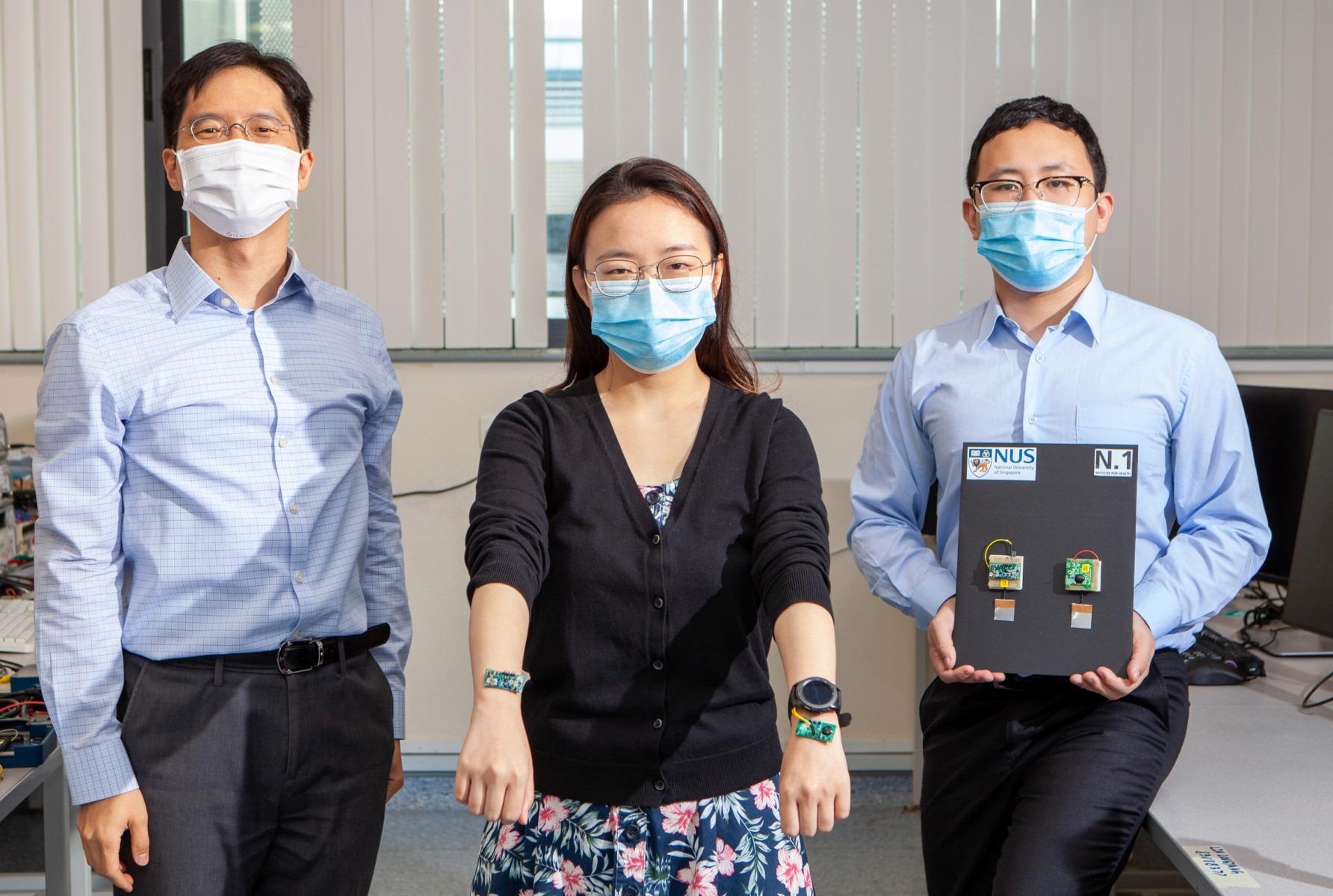Jun 11 2021
Developments in wearable technology are transforming the way people live, work, play, as well as how healthcare is given and received.
 A team led by Associate Professor Jerald Yoo (left) has developed a novel wireless powering solution for wearables. With him are two team members: Ms Li Jiamin (center), who has a transmitter on her right wrist and a receiver connected to a smartwatch on her left wrist, and Mr Dong Yilong (right) who is holding a panel displaying the technology. National University of Singapore.
A team led by Associate Professor Jerald Yoo (left) has developed a novel wireless powering solution for wearables. With him are two team members: Ms Li Jiamin (center), who has a transmitter on her right wrist and a receiver connected to a smartwatch on her left wrist, and Mr Dong Yilong (right) who is holding a panel displaying the technology. National University of Singapore.
Wearables that have found their way into daily life include wireless earphones and smartwatches, whereas in the healthcare setting, general devices include listening aids, electrocardiogram (ECG) monitoring patches, wearable injectors and more.
However, a major problem facing the use of these wearables is the difficulty to keep them properly and easily powered. As the use of wearables increases, the need to charge many batteries also increases simultaneously, consuming huge amounts of electricity. A number of users find it tedious to charge multiple devices on a daily basis and inopportune service disruptions occur when batteries expire.
A group of researchers, headed by Associate Professor Jerald Yoo from the Department of Electrical and Computer Engineering and the N.1 Institute for Health at the National University of Singapore (NUS), has now come up with a solution to address these issues.
The researchers’ technology allows an independent device, like a mobile phone positioned in the pocket, to wirelessly charge other wearable devices on a user’s body, simply using the human body as a medium for power transmission. This innovative system has an added benefit — it can harness the unused energy from electronics in a typical office or home environment to power the wearables.
The researchers’ achievement was first published in the Nature Electronics journal on June 10th, 2021. It is the first-of-its-kind achievement to be established among current literature on electronic wearables.
Using the Human Body as a Medium for Power Transmission
To expand the life of batteries and make them completely autonomous — yet wireless — operations of wearable devices, energy harvesting and power transmission approaches are needed. But traditional methods to power up body area wearables are restricted by the distance that power can be transmitted, the stability of energy movement, and the “path” the energy can travel without encountering obstacles.
As such, none of the existing techniques have been able to offer sustainable power to wearables positioned around the whole human body.
The NUS researchers thus decided to overcome these restrictions by developing a receiver and transmitter system that utilizes the human body — the exact obstacle in wireless powering — as a medium for energy harvesting and power transmission. Every receiver and transmitter feature a chip that is utilized as a springboard to expand the coverage across the full body.
A user simply needs to position the transmitter on a single power source, like the smartwatch on a user’s wrist, whereas numerous receivers can be positioned anywhere on the body of a person. Subsequently, the system harnesses energy from the source to charge numerous wearables on the user’s body through a process called body-coupled power transmission.
In this manner, the user only needs to charge a single device, and the rest of the gadgets that are worn can concurrently be charged from that one source. The experiments performed by the team demonstrated that their system enables a single power source that is completely charged to power up to 10 wearable devices on the body, for a period of over 10 hours.
As a complementary source of power, the researchers also considered harvesting energy from the surroundings. Their study revealed that typical home and office surroundings have parasitic electromagnetic (EM) waves that people are subjected to all the time, for example, from a running laptop.
The researchers’ new receiver scavenges the EM waves from the ambient surroundings and with the help of a process known as body-coupled powering, the human body has the ability to exploit this energy to power the wearable devices, irrespective of their locations around the body.
Paving the way for Smaller, Battery-less Wearables
Batteries are among the most expensive components in wearable devices, and they add bulk to the design. Our unique system has the potential to omit the need for batteries, thereby enabling manufacturers to miniaturise the gadgets while reducing production cost significantly. More excitingly, without the constraints of batteries, our development can enable the next generation wearable applications, such as ECG patches, gaming accessories, and remote diagnostics.
Jerald Yoo, Associate Professor, National University of Singapore
The NUS group will continue to improve the powering efficiency of their transmitter and receiver system and believes that in the future, any specified power-transmitting device, be it a user’s smartwatch or mobile phone, can meet the network power demands of all other wearables on the body and thus lead to an extended battery life.
Journal Reference:
Li, Y., et al. (2021) Body-coupled power transmission and energy harvesting. Nature Electronics. doi.org/10.1038/s41928-021-00592-y.